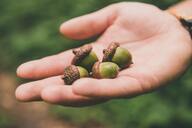CONSERVATION CORNER
A weekly blog for all things conservation
 By: Tori Bristol, Dirt and Gravel Roads Specialist Last week we talked about The Mighty Oak Tree, and this week we are focusing on how to collect and plant acorns to successfully grow them. “The best time to plant an oak tree was twenty years ago. The second best time is today.” This time of year is the best time to start collecting, acorns are best harvested in the early-to-mid autumn however they can still be collected up until winter. (Remember save some acorns for the wildlife that depend on them for food!) Choose acorns that are free of worms, holes, and fungus. A good test to see if the acorn is “good” is to submerge them in water. Any acorns that float are no good and acorns that sink are healthy and have a better chance of growing. Suitable acorns should be brownish with slight tinges of green remaining, though the appearance of acorns can vary based on the type of oak tree they come from.
Refrigerate the acorn to mimic the winter season. Place in a plastic bag with peat moss, add a small amount of water, but do not drench the acorn or moss. You will want to keep the acorn around 35 degrees, and keep it in the fridge until springtime of the following year. Check the acorn periodically to ensure it is still damp and add water as needed. Around April, plant the acorn in a small planter, poke holes in the bottom of the planter to ensure adequate drainage. Fill the planter to nearly the top using an equal mix of quality potting soil and peat moss. Place the acorn in the dirt near the top, but totally cover it with soil mix. Place the acorn horizontally so the cap and the tip are pointing at the edges of the planter and not the bottom of the planter. Keep the planter in a sunny location and wait for growth. Keep the dirt moist, but not soaked. The acorn should sprout within a week or so. Sometime in May, the seedling should be a half-foot tall with leaves. You can take the planter outside during the day once the seedling sprouts and has a second set of leaves. Bring the container back in at night and protect the plant when it's outside so animals don't disturb it. Transplant the seedling to a larger planter, consider using a 10- to 12-inch pot. This can be done around June. Use the same soil mixture as before, and ensure proper drainage. The planter can be left outside at all times. Permanently plant the tree outdoors in the fall. Choose a location that can handle a large tree. The oak tree will grow slowly but it will become a large tree someday. Use quality soil and provide adequate mulching and consider staking around the tree to avoid damaging it with a lawnmower. If planting the oak seedling in your yard, remember that years from now that beautiful tree will deposit a plentiful crop of annual acorns. Some yard crew members might consider this a nutty job. However, few would argue the majesty of the mighty oak tree growing in wide open spaces. It is a sight to behold. The Bradford County Conservation District is committed to helping people manage resources wisely. You can visit the Bradford County Conservation District at 200 Lake Rd in Wysox across from the Wysox Fire Hall. Contact us at (570) 485-3144 or visit our web page at www.bccdpa.com.
0 Comments
Leave a Reply. |
AuthorsVarious staff at the Bradford County Conservation District Archives
July 2024
Categories
All
|
|
Bradford County Conservation District
Stoll Natural Resource Center 200 Lake Road, Suite E | Towanda PA 18848 Phone: (570)-485-3144 |
